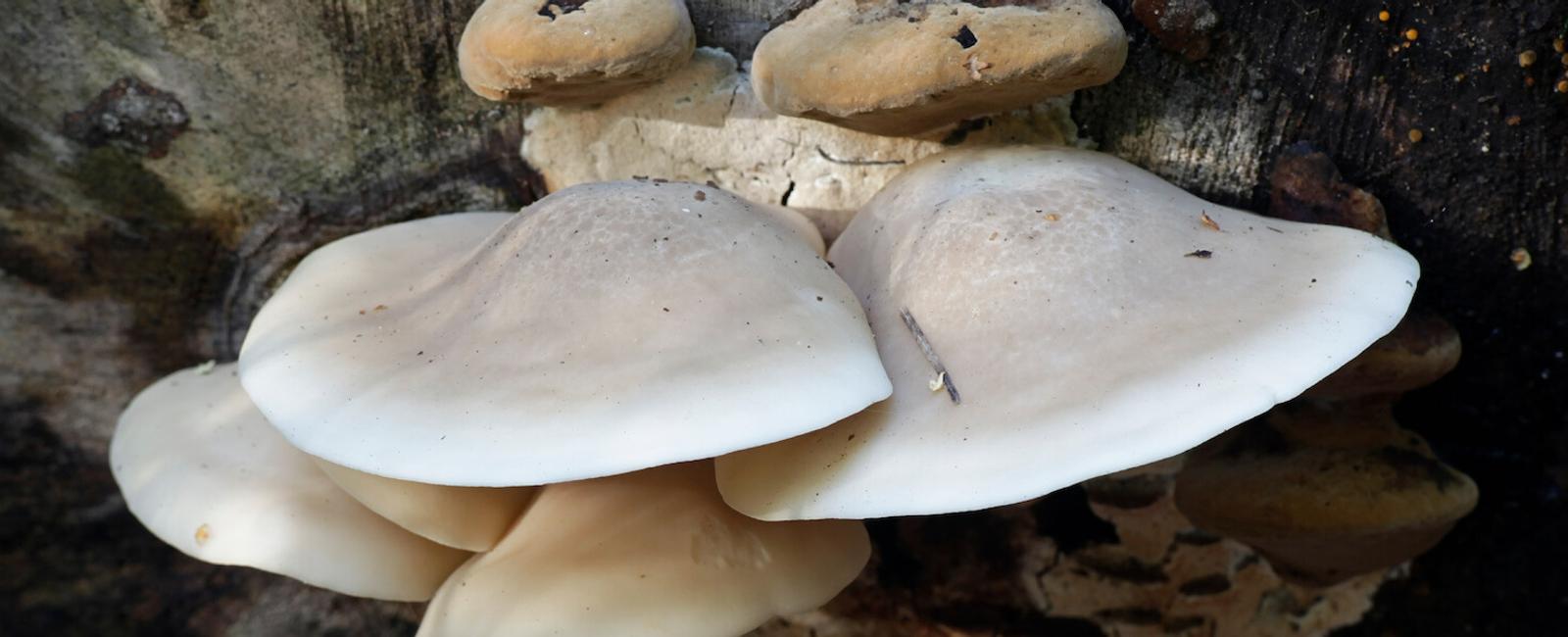

Some of the most delicious mushrooms you’ll find are those you won’t often see in your local supermarket. One such hidden gem is the elm oyster mushroom. With its unique taste and health benefits, the elm oyster mushroom is a culinary delight that deserves more recognition.
In this guide, you’ll learn all about elm oyster mushrooms, where they grow, and what they look like. We’ll talk about their health benefits, how you can enjoy them, and much more.
What are elm oyster mushrooms?
Elm oyster mushrooms (Hypsizygus ulmarius) are somewhat rare mushrooms that look and grow similarly to oyster mushrooms (Pleurotus ostreatus), although they’re not related. Interestingly, elm oyster mushrooms are considered to be more delicious than oyster mushrooms, with a superior flavor and texture. (Hard to imagine, we know!)
These shrooms also go by the common names of white elm mushroom and Shirotamogitake (Japanese for white elm mushroom) (1).
It’s not unusual for mushroom taxonomy to shift and change over the years. Mycologist Paul Stamets explains how elm oyster mushrooms were initially identified as Pleurotus ulmarius because of their oyster mushroom-like appearance. That would eventually be replaced by Lyophyllum ulmarium and updated again to its current classification of Hypsizygus ulmarius (1).
What do elm oyster mushrooms look like?
True oyster mushrooms belong to the Pleurotus genus and grow in a characteristic fan shape and shelf-like formation. Elm oyster mushrooms, on the other hand, have more traditional mushroom-shaped caps and stems. Both of these mushrooms look similar when viewed from above.
Elm oyster mushrooms are uniform in color and can be tan, beige, grayish brown, and gray. They range from 4-15 cm (1.5-6 inches) in size and can have undulating caps as they age. These are gilled mushrooms; more specifically, their gills are decurrent, which means their gills extend down the stem of the mushroom instead of stopping where the cap meets the stem (1).
Where do elm oyster mushrooms grow?
Elm oyster mushrooms grow in small clusters of two to three mushrooms (and more often singly) high up on trunks and branches of hardwood trees like beech, cottonwoods, maple, willow, oak, boxelder, and elm trees (1) from August through December (2).
These mushrooms grow in temperate forests throughout North America, Europe, and Japan. They’re also likely found in other parts of the world with similar climates (1).
Historical and traditional use of elm oyster mushrooms
Traditional medicine schools have used wild mushrooms for centuries, with thorough documentation of mushrooms such as reishi, lion’s mane, chaga, and others.
But unlike these other well-known mushrooms, elm oyster mushrooms haven’t been nearly as well documented, so we don’t have much information on how elm oyster mushrooms may have been used in traditional Chinese medicine (TCM). We know mushrooms in the same family as elm oyster mushrooms are recommended in TCM for treating stomach and intestinal issues (1).
However, without more documentation, we can’t definitively say how elm oyster mushrooms may have been used in traditional medicine schools.
Health benefits of elm oyster mushrooms
According to Stamets, much of the research on elm oyster mushrooms has been conducted in Japan, and anecdotal reports have suggested these shrooms have anticarcinogenic properties.
One study comparing elm oyster mushrooms to white button mushrooms (Agaricus bisporus) and milky mushrooms (a mushroom popular in India) found elm oyster mushrooms had more antioxidant properties than either of the other mushrooms and is attributed to their high phenol content (3).
There’s been a growing interest in learning more about the phenolic acids and flavonoids found in edible mushrooms as they play a pivotal role in the human body, displaying antioxidant, anti-inflammatory, antitumor, and antimicrobial activities (4).
Ethically wildcrafting elm oyster mushrooms

Before you pack a lunch and head out to gather mushrooms, there are a few essential things to learn about ethically wildcrafting elm oyster mushrooms. While foraging and wildcrafting may sound the same, they can vary widely in their approaches.
Foraging is typically used as a catchall term for gathering food resources in the wild, with foragers seeking out berries, nuts, herbs, plants, mushrooms, and more. Ethical wildcrafting is defined as harvesting local resources for medicinal needs. A noteworthy differentiation between the two is the focus wildcrafting places on the effects harvesting has on a local environment.
Learning the local area
It’s wise to familiarize yourself with the local area where you’ll gather your elm oyster mushrooms. Do research whether you need any permits or other special permissions for where you plan to collect your mushrooms.
You’ll want to know if there are any threatened or endangered mushroom species in the area and, even more importantly, whether there are any potentially dangerous look-alikes or toxic mushrooms in the area. Proper mushroom identification is essential, especially with an edible mushroom. Consult a field guide for guidance on knowing what you’re wildcrafting. We strongly recommend consulting with a professional if you aren’t sure what you’re gathering.
Mushroom anatomy and proper harvesting
An essential aspect of mindful wildcrafting involves learning about mushroom anatomy and proper harvesting techniques.
When we see a mushroom, it’s easy to think we’re seeing the whole mushroom when we’re really seeing only part of it. What we see above ground or neatly packaged at the grocery store or farmer’s market are the fruiting bodies of a mushroom. And they’re only half of the mushroom equation.
The mycelium is hidden just beneath the surface, a fascinating and complex web of tiny, delicate filaments called hyphae. Responsible for everything from nutrient uptake to communication between mushrooms, trees, and their environment, this sophisticated network is sometimes called the “wood wide web,” signifying its vast and widespread nature.
Proper harvesting techniques preserve this vital network and help mushroom populations grow abundantly after picking. Always bring the appropriate tools for the mushrooms you plan on gathering.
While there’s debate as to whether it’s better to gently twist a mushroom free from the earth or carefully cut it at the base of its stem, as long as you aim to keep as much of the mycelium intact as possible, you’re doing your best to minimize your impact on the local environment.
Ecosystem preservation
Remember, we aren’t the only ones who feast on mushrooms. Birds, rodents, deer, insects, and other creatures rely on mushrooms for food. Ethical wildcrafting keeps this in mind and only gathers a portion of the mushrooms available, leaving enough for the populations to grow back—all while leaving the local ecosystem as untouched as possible.
You can make a spore print once you’ve gathered your elm oyster mushrooms. Exactly what it sounds like, a spore print can make it easier to identify mushrooms, but it can also help you grow mushrooms at home.
We won’t get into all the details here, but with some know-how and patience, you can start growing your delicious elm oyster mushrooms from home. A grow kit can make it easy, and learning about substrate (like sawdust), mushroom culture, and mushroom spawn can help the process go even more smoothly.
How can you enjoy elm oyster mushrooms?

You can use elm oyster mushrooms like any other fresh mushroom in your kitchen, adding them to soups, stews, risotto, stir-fries, and more. Here are a few easy recipes to kickstart your adventures in the kitchen.
Easy sauteed mushrooms with garlic
Simple sauteed mushrooms are easy to prepare any day of the week. With only five minutes of prep, this dish can be ready in under half an hour. Gently caramelizing your mushrooms brings out their earthy flavor, and this recipe makes it easy to use any other gourmet mushrooms you have on hand, like king oyster mushrooms, cremini mushrooms, or king trumpet mushrooms.
Cozy elm oyster mushroom soup
Even though this recipe calls for oyster mushroom soup, since elm oyster mushrooms have a reputation for being even more delicious, this is the perfect place to make an ingredient swap. Filled with aromatics like lemongrass, leeks, ginger, and garlic, this savory soup with a touch of miso is brimming with unbeatable umami flavor.
Mushroom tartine
Think of a tartine as an open-face sandwich, and consider this mushroom tartine an opportunity to seriously up your sandwich game. Herby chestnut and elm oyster mushrooms are gently sauteed before being piled upon a toasted piece of sourdough smeared with brie and finally topped with cucumber, radish, pickled shallots, and lemon zest. Add a simple side salad for a complete and delicious meal that will be a new favorite in no time.
Elm oyster mushrooms: A delicious woodland find
With their delicious flavor, elm oyster mushrooms might become your new favorite culinary mushroom. And with their promising health benefits and robust phenol profile, you can trust you’re nourishing your body inside and out.
Be sure to keep up with all things mushroom on shroomer, where you’ll learn more about identification and all the latest breakthroughs and discoveries on functional and psychedelic mushrooms.
References
- Stamets, Paul. Growing Gourmet and Medicinal Mushrooms. Ten Speed Press, 2011. https://fungi.com/collections/books-by-paul-stamets/products/growing-gourmet-and-medicinal-mushrooms
- Mushroom Identification - Ultimate Mushroom Library. “Hypsizygus Ulmarius: The Ultimate Mushroom Guide,” n.d. https://ultimate-mushroom.com/edible/86-hypsizygus-ulmarius.html
- Dandamudi, Rajesh Babu, and G. Nageswara Rao. “Antioxidant Properties and Electrochemical Behavior of Cultivated Commercial Indian Edible Mushrooms.” Journal of Food Science and Technology 50, no. 2 (March 24, 2011): 301–8. https://doi.org/10.1007/s13197-011-0338-8
- Abdelshafy, Asem Mahmoud, Tarun Belwal, Ze Liang, Lei Wang, Dong Liu, Zisheng Luo, and Li Li. “A Comprehensive Review on Phenolic Compounds from Edible Mushrooms: Occurrence, Biological Activity, Application and Future Prospective.” Critical Reviews in Food Science and Nutrition 62, no. 22 (March 17, 2021): 6204–24. https://doi.org/10.1080/10408398.2021.1898335


